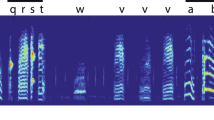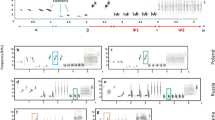Summary
To examine the properties of avian song memorization, handraised nightingales (Lusdnia megarhynchos) were exposed to three strings composed of 21 or 12 different song types (Fig. 1) which they heard only during the tutoring programs. The analysis of the birds' singing performed several months later revealed a kind of song memorization and production which, hitherto, had not been studied in song birds and is called ‘package formation.’
Each package was a temporally consistent group of acquired song types which could be traced back to a coherent succession of, usually, three to five (max. seven) model song types. Model song types which a bird failed to acquire were located outside those sequences of model song types that had been acquired and later formed the packages. In contrast to the order of the tutored strings, packages were sung in a variable order. In parallel, neither the frequency of occurrence of the packages nor the performance length was related to the size of the package.
We infer from these results that package formation reflects basic properties of the nightingales' song-type memories, which — through segmentation of serially presented learning stimuli — may facilitate the acquisition of large signal repertoires.
Similar content being viewed by others
References
Bower GH, Hilgard ER (1981) Theories of learning, 5th edn. Prentice Hall, Englewood Cliffs
Estes WK (1972) An associative basis for coding and organization in memory. In: Melton AW, Martin E (eds) Coding processes in human memory. Winston, Washington DC, pp 161–190
Estes WK (1984) Human learning and memory. In: Marler P, Terrace HS (eds) The biology of learning. Springer, Berlin Heidelberg New York, pp 617–628
Freyschmidt J, Kopp ML, Hultsch H (1984) Individual development and differentiation of acquired song patterns in nightingales. Verh Dtsch Zool Ges 77:244
Hultsch H (1980) Beziehungen zwischen Struktur, zeitlicher Variabilität und sozialem Einsatz des Gesangs der Nachtigall (Luscinia megarhynchos). PhD thesis, Fakultät Biologie, Freie Universität Berlin
Hultsch H (1985) Formation of sub-repertoires: a strategy to support development and performance of large vocal repertoires. Verh Dtsch Zool Ges 78:229
Hultsch H, Todt D (1981) Repertoire sharing and song post distance in nightingales. Behav Ecol Sociobiol 8:183–188
Hultsch H, Todt D (1989) Song acquisition and acquisition constraints in nightingales,Luscinia megarhynchos. Naturwissenschaften 76:83–85
Hultsch H, Lange R, Todt D (1984) Pattern type labeled tutoring — a method for studying song-type memories in repertoire birds. Verh Dtsch Zool Ges 77:249
Isaac D, Marier P (1963) Ordering of sequences of singing behaviours of mistle thrushes in relationship to timing. Anim Behav 11:89–94
Kintsch W (1982) Gedächtnis und Kognition. Springer, Berlin Heidelberg New York
Konishi M (1965) The role of auditory feedback in the control of song in the white-crowned sparrow. Z Tierpsychol 22:770–783
Konishi M (1985) Bird song: from neuron to behaviour. Annu Rev Neurosci 8:125–170
Kroodsma DE (1982) Learning and the ontogeny of sound signals in birds. In: Kroodsma DE, Miller EH (eds) Acoustic communication in birds, vol 2. Academic, New York, pp 1–23
Lemon ER, Chatfield C (1971) Organization of song in cardinals. Anim Behav 19:1–17
Marler P (1984) Song learning: innate species differences in the learning process. In: Marier P, Terrace HS (eds) The biology of learning. Springer, Berlin Heidelberg New York, pp 289–309
Nottebohm F, Stokes TM, Leonard CM (1976) Central control of song in the Canary,Serinus canarius. J Comp Neurol 165:457–486
Thimm F, Clausen A, Todt D, Wolffgramm J (1974) Zeitabhängigkeit von Verhaltensmusterfolgen. J Comp Physiol 84:311–334
Todt D (1970) Gesangliche Reaktion der Amsel auf ihren experimentell reproduzierten Eigengesang. Z Vergl Physiol 66:294–317
Todt D (1975) Short term inhibition of vocal outputs occurring in the singing behaviour of blackbirds (Turdus merula). J Comp Physiol 98:289–306
Todt D, Hultsch H (1985) Zum Einfluß des vokalen Lernens auf die Ausbildung gesanglicher Repertoires bei Drosselvögeln. In: Tembrock G, Siegmund R, Nichelmann M (eds) Verhaltensbiologie. Fischer, Jena, pp 22–34
Todt D, Wolffgramm J (1975) Überprüfung von Steuerungssystemen zur Strophenanwahl der Amsel durch digitale Simulierung. Biol Cybern 17:109–127
Todt D, Hultsch H, Heike D (1979) Conditions affecting song acquisition in nightingales (Luscinia megarhynchos). Z Tierpsychol 51:23–35
Author information
Authors and Affiliations
Rights and permissions
About this article
Cite this article
Hultsch, H., Todt, D. Memorization and reproduction of songs in nightingales (Luscinia megarhynchos): evidence for package formation. J. Comp. Physiol. 165, 197–203 (1989). https://doi.org/10.1007/BF00619194
Accepted:
Issue Date:
DOI: https://doi.org/10.1007/BF00619194




